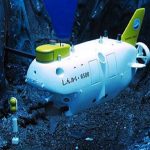Explorers
When people in history explored new lands, they had no idea what they were going to find. Christopher Columbus set out in search of a new world, not knowing that the Earth wasn’t flat. He had no idea what was in store for him. The same is true with the prospectors who headed to California in search of gold. Even today, people are out searching for things and then end up finding something completely different.
Lake Van
Lake Van is the largest body of water in all of Turkey. It is located over 5,000-feet below sea level, and it never freezes. This is because the lake’s high salinity keeps the water flowing all year long. This strange phenomenon has come at the price of Lake Van’s biodiversity.
Under the Sea
Due to the high levels of salt in the water, there is only one type of fish in the waters, the Pearl Mullet. According to legend, these mackerel-sized fish aren’t the only
The Video
The video that he captured showed a large monster that resembled a squid coming up from the water before it slowly disappeared in the waves. Even though he caught the whole thing on video, there are still some scholars who aren’t sure if this creature really does exist.
Lake Exploration
Although it may have been proven that this creature does exist and is living under the waters in Lake Van, archaeologists are still heading out and exploring the lake. Recently, an expedition led divers to the bottom of the lake and what they found like something they had never seen before. Turkish divers searching for lake monster uncover a 3, 000-year-old mystery.
The Reason
The search was performed by a group of researchers assembled by Van Yuzunci Yil University. They were there to debunk another age-old myth. They wanted to prove that the lost city of Atlantis wasn’t under the waters of Lake Van. The reason they thought this was because the land surrounding the lake was once home to the Urartians, which was an ancient civilization that flourished in Turney during the Iron Age over 3,000 years ago. Today, very few remnants of these people and the city remain.
Tahsin Ceylan
Tahsin Ceylan was asked to lead the expedition due to his years of diving experience. He also had extensive knowledge of Lake Van. The people funding the expedition were sure that he was their best bet in locating the lost city or debunking its existence.
Weary
When it came time for Tahsin to get into the water, he was a bit weary. He had been in these waters many times, and each time, he wondered it would be the day that he came face-to-face with the terrifying monster. His team was also a bit nervous. The water was large and murky, and nobody knew exactly what lied below the surface.
Combing the Lake’s Bottom
When the team got to the bottom of the lake, they began combing the sand for signs of
Still No Answers
Despite their find, scholars are still skeptical regarding Tahsin’s team’s discovery. They believed that the lion symbol was from the Middle Ages and not the Iron Age. The archaeological community remains split about the find beneath Lake Van. The scholars who do believe that the castle was from the ancient civilization believe this because they say that the stones used to build it were a mix of both Unitarian and medieval. With the archaeological community split in their belief, there are no definitive answers. This could be the remnants of the lost civilization, or it could be what is leftover from another. Either way, it was an incredibly amazing find.


